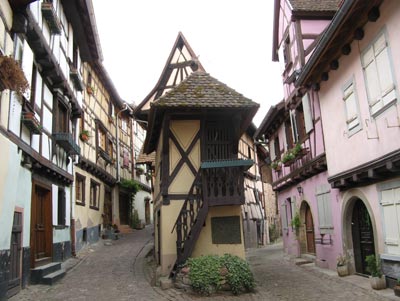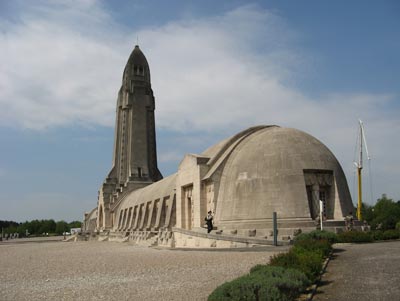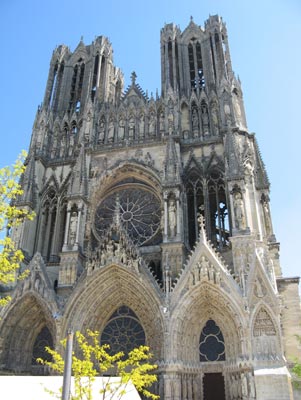France — touring Alsace and Burgundy by car
by Richard Berner, San Diego, CA
After a wonderful week in Paris staying in a rental apartment in the 11th arrondissement, we picked up our Europcar rental at Charles de Gaulle Airport on May 2, 2007. From the airport, we headed for Reims in the Champagne region of northeastern France.
To begin, Champagne
Our destination was the Grand Hotel Continental (93 place Drouet d’Erlon; phone +33 [0] 3 26 40 39 35, www.grandhotelcontinental.com). The hotel was comfortable and well located on the pedestrian square in the center of town, with easy underground parking nearby (€6). Our double room with private bath cost €105 ($166) per night.
While in Reims, we took a tour of the champagne cellars of G.H. Mumm. They have 25 kilometers of tunnels, mostly dug by fourth-century Romans, in the chalk soil underneath the city. These keep their champagne at the correct temperature needed for it to mature. At the end of the tour, they offered tastes of two different champagnes; both of us liked their less expensive one, Cordon Rouge, better.
We toured impressive Reims Cathedral, dating from the same era as Notre Dame in Paris (early 13th century). Charles VII’s coronation was held there with Joan of Arc at his side.
The more modern stained-glass windows by Marc Chagall were a highlight. However, many of the 2,000-plus statues on the exterior of the cathedral have deteriorated and are in need of restoration.
We had an excellent dinner at L’Apostrophe (59, place Drouet d’Erlon; www.restaurant-lapostrophe. com), our introduction to the delicious marriage of German and French cooking that is prevalent throughout this region. Our two daily specials — Martha had roast pork with potatoes and I had spätzle with ham and spinach — cost €22 ($35) plus €12 for a bottle of wine.
We had our worst meal of the trip at the Glue Pot Restaurant, two doors north of L’Apostrophe.
Aux Choix, located directly across the square from Hotel Continental, had excellent lunch salads for €8 each.
Verdun
Leaving Reims, we drove farther east to Verdun. This area was the location of one of the bloodiest battles of WWI. Germany annexed the area of Alsace-Lorraine in 1871, so Verdun was on the border between Germany and France. The French built defensive fortifications in the area to help protect them from an aggressive Germany.
Over 800,000 troops died at Verdun from 1914 to 1918, the casualties somewhat evenly divided between French and German soldiers and including a few thousand Americans. We drove through the former battlefields, where many of the trenches used in the fighting are still visible.
We visited Fort Douaumont and the Ossuarie de Douaumont, containing the remains of 130,000 fallen soldiers. In front of the ossuary were large graveyards with manicured lawns and white crosses, reminiscent of Normandy, as well as Muslim markers for the soldiers from formerly French Morocco who fought for France in WWI.
Just north of the ossuary we had a good lunch at Café Abri des Pèlerins (phone 03 29 84 35 38). Martha had an omelet and I had a croque monsieur, a grilled ham-and-cheese sandwich (€14, total). We could have just shared the omelet, as it covered the plate and came with frites.
Colmar
We drove east toward the German border, turning south to the town of Colmar in the Alsace region. Our lodging in Colmar was Hotel du Turenne (10, route de Bâle; phone +33 [0] 3 89 21 58 58). We liked our spacious room (€62) except for the noisy, accordion-style door to the bathroom. Parking was available for €6.50 a day.
We were close to an area of Colmar called Petite Venise (Venice). This area is laced with canals that originally were used as a water supply by the local tanners and to transport produce to market. We enjoyed a glass of wine alongside a picturesque canal at Wistub La Krutenau (1 rue de la Poissonnerie).
Dinner was at nearby Le Petite Venise (4 rue de la Poissonnerie; phone 03 89 41 18 80), a cute, 8-table place run by a friendly young couple. Our excellent dinners — pork loin and escargot — with wine, shared dessert and coffee cost €40 ($63).
In the morning, we partook in our hotel’s extensive breakfast buffet (€7.50) before walking to the Unterlinden Museum, known for its religious art. I am not normally a big fan of this type of art, but the included audio guide made it more interesting, for me.
The highlight of the museum was the Isenheim Altarpiece (1515) by Matthias Grünewald. This series of paintings, attached by hinges, was intended to help people suffering from terrible skin diseases. By seeing the suffering of Christ depicted on the panels, it was hoped that they would feel better about their own misfortune.
We also stopped at the Dominican Church to see their famous painting, “Virgin in the Rosebush,” dated 1473.
We followed this with a self-guided walking tour of Colmar’s medieval half-timbered buildings. There were occasional rain showers and we ducked into stores to stay dry.
Dinner was at Le Roessler (place des Six Montagnes Noires), where we had a good pizza with salad and wine for €20.
Casual touring
The next day was our 41st wedding anniversary. We drove north of Colmar along the Route des Vins d’Alsace (Alsace wine route), stopping at several towns.
First was picturesque Riquewihr, where we walked through town and took a tram ride out into the surrounding vineyards. We bought a few bottles of wine after tasting several varieties.
In less-crowded Hunawihr, we visited their 16th-century fortified church and saw several storks with their huge nests — a symbol of the Alsace region.
Kaysersberg had numerous outdoor cafés that made strolling and shopping their wide main street a pleasant experience.
We drove through several other towns along the route but were discouraged by the crowds or lack of parking.
In the evening we had an excellent dinner at a Lebanese/Syrian restaurant, Palmyre (Grand Rue and rue du Canard, Colmar). I had a kebab with rice and Martha had a chicken shawarma dish. With a fresh tomato-and-cucumber salad, our dinners cost €32 including wine.
The next morning we drove south to Eguisheim, another of the cute villages along the wine route, for the day. We walked the former ramparts, now a narrow street of medieval-era buildings.
Our substantial lunches at the outdoor café on place du Château were delicious and inexpensive (€18). I had potato salad with smoked meats and Martha had a meat torte.
On to Burgundy
We drove west from Colmar toward Dijon, then south to Beaune in the Burgundy region of France. We had called ahead for reservations at Hôtel de La Paix (45 rue du Faubourg Madeleine; phone 33 [0] 3 80 24 78 08, www.hotelpaix.com), where they offered us a huge attic room with three beds plus a convertible couch and sitting area (€80). The room and bathroom had been recently redone and they sparkled. It was more like a suite.
We were pleased with the hotel, which also offered free parking and, in the lobby, free Internet use. The proprietor, Fernando, was very friendly but had limited English skills.
We had a good dinner at Relais de la Madeleine (44 place Madeleine, phone 03 80 22 07 47). I had roast lamb and Martha had beef Bourguignon. The owner was a character and the only English he seemed to know was “No problem,” which he said frequently and loudly.
Our meals cost €40 with a half bottle of chardonnay. Martha was glad to hear that all the white wines of Burgundy are made from chardonnay grapes, as chardonnay is her favorite wine.
Touring Beaune
In the morning we walked to the main square in Beaune and had a petite déjeuner at a café on the south side of place Carnot. We window-shopped around the area, and at lunch we returned to the same café.
We were seated at a long, communal-style table and struck up conversations with the couples on both sides of us. On one side was a friendly senior French couple who insisted on sharing their cheese plate with us. Martha enjoyed practicing her rusty French with them.
There was an American couple from Florida, Michael and Jean, on the other side, and they shared their wine with us.
It was sprinkling out, and the café was very crowded but cozy, so we had a long, enjoyable lunch discussing travel with nice people.
In the afternoon we went to the Hôtel-Dieu, a medieval charity hospital built in 1443. It was in wonderful condition, for its age, and decorated very nicely. Parts of it were still in use as a maternity hospital as recently as 30 years ago.
Afterward we went to nearby Marché aux Vins (2, rue Nicolas Rolin) for some serious wine tasting. For a fee of €10, they gave us little metal cups and turned us loose to try many different wines.
In the morning we toured La Fallot Moutarde (phone +33 [0] 3 80 22 10 02) in Beaune, one of the few family-owned mustard producers remaining in the Dijon area. Larger corporations have acquired almost all the others.
We learned about the production process and made some mustard of our own by grinding seeds and oil in a bowl.
A pleasant surprise
We left Beaune to explore some of the surrounding vineyards and villages. This is a beautiful area and we stopped to take photos a few times.
We went through the villages of Pommard and Montrachet, keeping an eye out for somewhere to have lunch. In Montrachet we saw a sign for Restaurant Le Chassagne (4 impasse des Chenevottes; phone 03 80 21 94 94). It looked a little upscale, but we decided to try it, as we hadn’t seen any alternatives.
Our multicourse lunch, at €76, cost more than we usually spend, but it was delicious. We were later told that the chef, Stéphane Léger, is well known and people travel to that area specifically to eat in his restaurant.
Back at the hotel, we sat down with our maps and guidebooks and debated what to do in the three days remaining before we had to be back in Paris to fly home. We called a hotel in Semur-en-Auxois and reserved a room for the next night.
Working our way back to Paris
Driving west on the more scenic secondary roads toward Paris, we stopped for lunch in the town of Saulieu and had an excellent meal. The restaurant was in Hôtel de la Poste (1 rue Grillot; phone 03 80 64 05 67, www.hotelposte.com), located on the main road, the N6. Martha had a different version of beef Bourguignon and I had a delicious potato-bacon-and-cheese casserole with a browned, crusty top. The young chef prepared the meals at a large fireplace in the dining area.
Our two lunches with wine cost €25. We later read that the town is known for its quality food.
We drove on to Semur-en-Auxois and checked in at Hôtel des Cymaises (7 rue du Renaudot; phone 03 80 97 18 23, www.hotel cymaises.com). They gave us the family room with two bedrooms, one with a king-sized bed and the other with twin beds, for €62 ($98).
We explored the town, known for having four medieval towers that are still standing and a jumble of narrow ancient streets. The towers were beautifully illuminated at night.
We decided to have dinner in our room, since it was more like an apartment. I went out and bought döner kebab sandwiches (the kind with the meat cut off of a large upright spit) with fries for €5 each. However, here these tasty sandwiches were on baguettes rather than the pita bread we were used to. We opened a bottle of “anniversary wine” that we bought in Beaune and had a delicious in-room feast.
The Cymaises offered a good and complete petite déjeuner (€6.50) in the morning.
Auxerre
We called Hotel Le Maxime in Auxerre, our next overnight destination, and reserved a room for that night. Soon after setting out, we stopped at the nearby village of Flavigny-sur-Ozerain, located 16 kilometers east of Semur-en-Auxois. This town is where the Oscar-winning movie “Chocolat” was filmed in 2000. We saw the storefront used as Juliette Binoche’s character’s chocolate shop in the movie.
We continued on to the town of Alise-Ste-Reine, where local legend says that the last of the Gauls were conquered by Rome in 52 B.C., thereby establishing Roman control over Gaul, or modern-day France. We saw many groups of schoolchildren visiting.
Our next stop was the Abbey de Fontenay, a 12th-century Cistercian abbey. It was a beautiful and immaculate site. We both enjoyed seeing the abbey and grounds and highly recommend a stop there if you are in the area.
We located Hôtel Le Maxime (2 quai de la Marine; phone 03 86 52 14 19, www.lemaxime.com) after making a few wrong turns in Auxerre. Our room was fine (€83) and overlooked the Yonne River, but our last two extraspacious rooms had spoiled us.
We walked uphill through the pedestrian center of the Old City, continuing along the river. There were several luxury barges parked along the quai in front of the hotel.
We had dinner in the Old City and once again had that well-known French favorite, pizza, salad and wine. Then we reserved a room for the next night at Hôtel Victoria in Fontainebleau, just southeast of Paris.
Fontainebleau
In the morning we again drove on secondary roads through the countryside toward Paris. Our room wasn’t ready when we arrived in Fontainebleau, so we parked and walked through town to the Château du Fontainebleau. It was an impressive place but has been much remodeled over the years by each successive ruler; most of what you see is not original. This was the home for many French kings before Versailles was built.
After strolling back through town and pausing for refreshments, we returned to Hôtel Victoria (112, rue de France; phone 01 60 74 90 00, www.hotelvictoria.com), where our room (€88) seemed a little worn at the edges. The hotel is in the process of being remodeled, so the rooms should improve. Free parking was available behind the hotel on the spacious grounds.
I liked the homey lounge area in the hotel with its big easy chairs and couches. We had a glass of wine and read some English-language magazines in the lounge before dinner, which was at a nearby Belgian restaurant. We both had delicious mussels with fries.
The hotel’s breakfast was very good and cost €8.
Vaux-le-Vicomte
Heading north back toward Charles de Gaulle Airport, we stopped to see Château Vaux-le-Vicomte near the town of Melun. A smaller version of Versailles, it was much more manageable and much less crowded. I could imagine people actually living there.
Louis XIV’s finance minister, Nicolas Fouquet, built Vaux-le-Vicomte, which was completed in 1661. When the king came to visit, he was jealous and became intent on destroying the minister. He later had Fouquet arrested on what were probably false charges. He hired the same architect, designer and landscaper that Fouquet had used and had them build Versailles — bigger, better (in his opinion) and more opulent.
Poor Fouquet never got out of prison, and some believe he was the inspiration for the Alexandre Dumas story, “The Man in the Iron Mask.”
We would recommend this château over Versailles.
We had a very good and reasonably priced lunch (€20 for two) at the cafeteria in the former stables on the property. Even in a cafeteria, the French do a pretty good job on food.
Wrapping up
We continued on to our destination for the night, the Ibis hotel at CDG airport (phone 01 49 19 19 19, www.ibishotel.com, hotel code 1404). We have stayed there several times on prior trips to France. After dropping off the rental car, we rode the new CDGVAL shuttle train to the hotel.
The rooms are standard cookie-cutter budget-hotel style, but they are clean and very efficient if you have a morning flight. The Internet rate we paid (€49) was for a nonrefundable, nonchangeable room.
We had a mediocre dinner in their dining room but a good buffet breakfast (€7) in the morning.
We enjoyed touring the Alsace and Burgundy regions. A rental car was nice to have, especially in the more rural areas. We both liked the wines better in Burgundy.
We found that advance hotel reservations were not usually necessary during early May. We would call ahead the night before or in the morning and were always able to get a room.
France has gotten more expensive, but it is still possible to travel somewhat reasonably. We carried Rick Steves’ guide to France, and I had photocopied selected sections out of Frommer’s and Lonely Planet’s guidebooks.
An additional book I would highly recommend is “Eating and Drinking in Paris” by Andy Herbach and Michael Dillon. It is compact in size but by far the most complete restaurant guide we have used in France.
Euros were readily available at ATMs everywhere we went.
Throughout our trip we found people helpful, and after seven trips to France we’re still looking for those snooty, rude Frenchmen everyone talks about.
If anyone has any questions, feel free to contact me by e-mail c/o ITN




